
St John the Baptist, BEDMINSTER
Bristol
c1003 - 1967
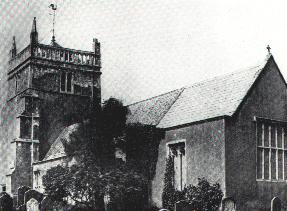
The church of St John the Baptist had an eventful history. The earliest record of a church dates from 1003, and it was the mother church to the most famous of Bristol's churches, St Mary Redcliffe which was officially a chapel-of-ease to Bedminster until 1852. It was important enough to have both a rector as well as a vicar. The Civil War saw the church, in whatever form it had grown into, burnt down by the order of Prince Rupert in September 1645. It was not rebuilt until 1663. The picture above dates from before 1855 and suggests that some remains of the burnt-out church were incorporated into the new structure. It does not seem to have been especially large - tower, nave, north aisle and chancel - and the stonework was in a poor state.
Matthew's Directory of 1793/4 has the following description:
"Bedminster Church, dedicated to St John Baptist, is very ancient; on the north-west abutment of the tower is a stone with a date 1003 upon it; so that it must have been built in the reign of King Ethelred. It is a vicarage, is mother Church to Redcliff and St Thomas in Bristol and Abbots-Leigh; the parish is of large extent and gives name to a hundred. The Church, (situated in a southern, large and populous suburb of Bristol) has two ailes, the longest about 90 feet, a gallery, several monuments and a handsome Alterpiece. The tower is large, low, has stone-railing and four pinnacles, and a rising between them on the top, which supports a vane: it has two bells, on the largest of which the hour is struck. This Church has the appearance of great antiquity, and stands in a very pleasant and rural Church-yard. On Easter and Whitmondays, vast numbers of young people flock from Bristol to a sort of revel held there on those days."
This church saw its last service on 25th June 1854, and was demolished in favour of a new church on the same site to a grand design by John Norton.
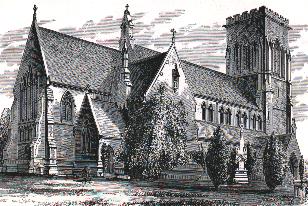
This view of the new church, from an early engraving, shows the church as built. It had a proud west tower, lofty clerestoried nave of six bays, aisles, north porch, and slightly lower chancel with transeptal bay to the west and a chapel or vestry to the east of this on the north side. Unusually a proud bellcote also was provided over the chancel arch for a sanctus bell. The tall broach spire planned for the tower was however never realised.
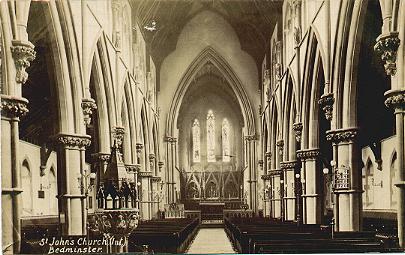
The interior was luxuriantly appointed, with much use of carved foliage and wall shafts and stringcourses. The new church was consecrated on 30th October 1855, although it had been ready earlier. The reason for this was the fine three-bayed reredos with many statues, which caused "widespread and violent opposition.....the intensity of the feeling engendered is seen from the fact that two wagonettes of clergymen, led by the Dean, drove to the Bishop's Palace in high dudgeon to lodge a protest." The church was the first parish church in Bristol to introduce a surpliced choir. Against the west wall could be seen a list of the rectors from 1086-1862, and vicars from 1189 to date.
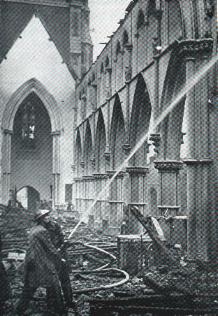
On the 24th November 1940 the church was burnt out by incendiary bombs. The picture above suggests the futile attempts to save it. However, the exterior walls, tower and the arcade and clerestory seem to have survived well, and restoration of the ruins must have been possible. However the church was to remain a ruin for another 27 years. As a small boy in the mid-1960s I can remember finding this church behind the shops in East Street, as my mother and I went for a walk. I remember a dark forboding ruin, like an abbey, amongst the trees, and was a little frightened! (Aaahhhw, shame!)
Oddly since then I had never ventured back to find it, and in recent years I believed the site to have been built upon. So in early 2000 I decided to see if the churchyard was still there, as Bedminster has undergone so many changes in recent years, especially in this area. The pictures below show what I found.
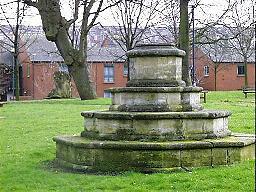
The ruins were finally cleared away in 1967. The churchyard has been made into a small public park, the tombs and headstones have been removed, and the area grassed and provided with benches. There seems to be nothing remaining of the church at all. This picture shows the base of a churchyard cross, probably in situ, and maybe pre-Victorian in part or site. The church lay in the space behind, and we would have been looking towards the north aisle here. If you look to the left of the large tree, there is something very odd. I will take you over there.
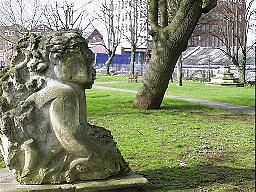
To orientate you, the churchyard cross is now on the right of the picture and this piece of stonework stands either inside the site of the Victorian church or close to the south aisle outside. Following my appeal on the first version of this page Dave Dann has been in touch to tell me that this is in fact a depiction of a "Green Man" by local artist Steve Joyce. (Thanks for getting in touch Dave, and apologies for the length of time it has taken to upload this second version.) Another view is seen below.
Dave also tells me that the humps in the churchyard are in fact created from the buried stone of the bulldozed church which were simply just buried.
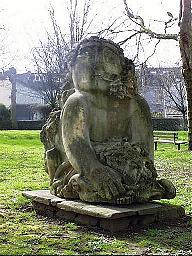
Back to Bristol churches Index